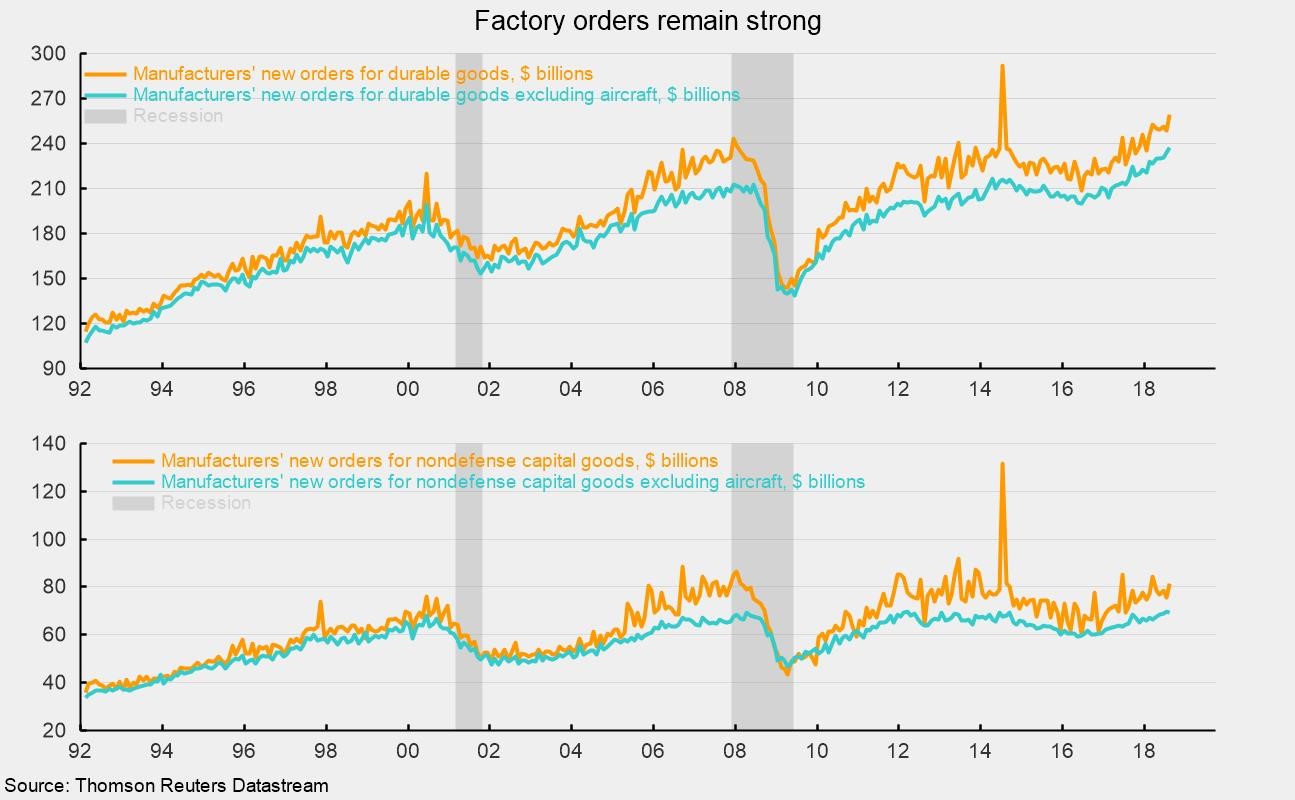Durable-Goods Orders Jump in August
New orders for durable goods jumped 4.5 percent in August, boosted by a 69.1 percent surge in nondefense aircraft and a 17.0 percent gain in defense aircraft. Because of the large per-unit price and the tendency for buyers to place orders for multiple aircraft at once, both of these series tend to be extremely volatile. If aircraft are excluded, new orders for durable goods increased 1.4 percent in August the third monthly gain in a row. Since June 2016, new orders for durables excluding aircraft have been on a strong uptrend, rising 18.7 percent (see chart).
The results for the categories of durable goods shown in the report were mixed in the latest month. Among the industries showing increases, orders for primary metals rose 0.9 percent, putting the year-to-date gain for 2018 versus the first eight months of 2017 at 16.7 percent; communications equipment rose 0.7 percent for the month and are up 8.4 percent for the year; electrical equipment and appliances orders were 0.6 percent higher in August and up 5.8 percent for 2018; and machinery orders were up 0.1 percent, pushing the year-to-date gain to 6.6 percent.
Categories showing declines for August are motor vehicles, down 1.0 percent for the month but up 6.3 percent in 2018, computers and related equipment, off 0.8 percent in August and down 12.2 percent from 2017, and the catchall “other durables” category, off 0.2 percent in August but still 4.3 percent ahead of last year. Orders for fabricated metal products were unchanged in August and are up 10.6 percent year to date.
Within the report on new orders for durable goods are data on new orders for capital equipment, or business investment. This subcategory is particularly important for two reasons. First, business investment can have a major impact on future productivity trends, and productivity is critical for helping offset cost increases as well as raising living standards over the long term. Second, capital-goods orders are important as they tend to be early indicators of turns in the business cycle. Real new orders for core capital goods — that is, real nondefense capital goods excluding aircraft — is one of the indicators in AIER’s Leading Indicators index.
On a nominal basis, new orders for core capital goods fell 0.5 percent in August following four consecutive monthly increases including a gain of 1.5 percent in July and 0.8 in June. In a manner similar to the broader durables-goods category, the trend of new orders for core capital goods has been solidly upward since mid-2016. New orders for core capital goods are up 17.1 percent since May 2016 (see chart again). Year to date, new orders for nondefense capital goods excluding aircraft are up 7.4 percent over 2017.
Other data out today include the latest weekly initial claims for unemployment insurance and revised estimates for second quarter Gross Domestic Product. For the week ending September 22, claims totaled 214,000, up 12,000 from the prior week. The four-week average came in at 206,250 versus 206,000 in the prior week. While claims rose in the latest week, they remain at historically low levels suggesting the labor market remains very tight.
The third estimate for second-quarter real GDP growth was unchanged at 4.2 percent. There were minor changes among the details in the report but the major implications remain the same. Real GDP growth bounced back in the second quarter and growth was fairly broad based.
Today’s data are positive overall. The report on durable-goods orders suggests that demand remains strong and that the broader economy is maintaining solid momentum in the second half of 2018. Combined with the latest favorable results of the AIER Leading Indicators index and other data on the labor market, business and consumer sentiment, household and corporate balance sheets, personal income, and corporate sales and earnings, the outlook remains positive with little risk of recession in the coming months and quarters.






